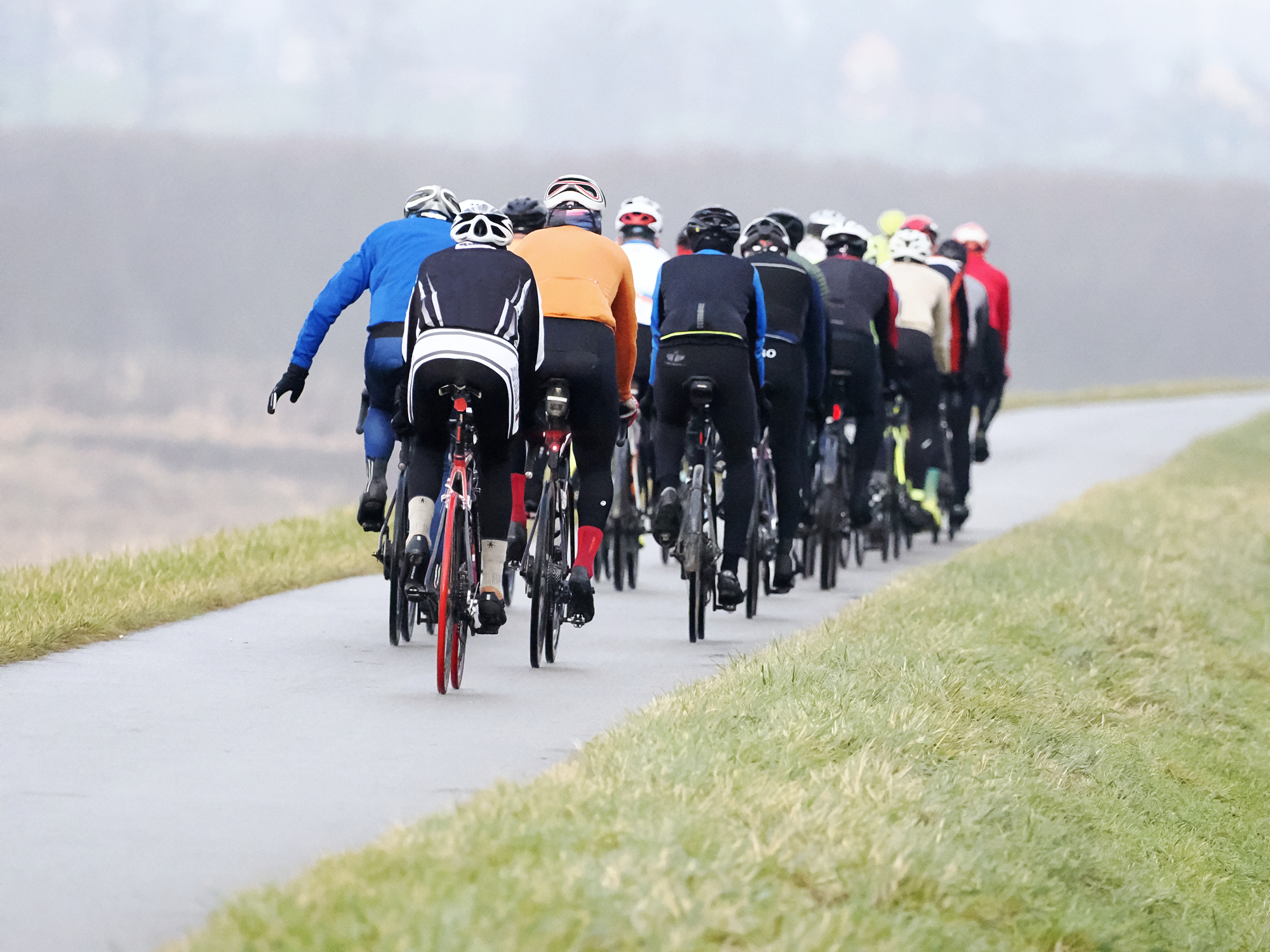Should I say 'car up' or something else to warn of cars when biking in a group?
Group riding warning calls are nothing if not eclectic. Here's how you warn of a car. Or not


There is a certain uniqueness that comes with riding in a group that is very difficult to replicate anywhere else. The hum of tyres on tarmac, the shared physical endeavour, the disgruntled shivering as you wait for someone to fix their third flat...
There are different approaches to the group ride, of course - it can be a chaotic sprinkling of riders, a frantic and fraught road race peloton of 100 or more, a well-drilled series of pairs - it can even be single file.
However you cut it though, the group has to have a way to communicate clearly to all riders at once. This is something that didn't really occur to me before I actually began group riding, and I imagine I'm not alone.
But there are simply too many obstacles to negotiate to leave each member of the group to spot them. More specifically, there are only two or three sorts of common obstacles, but there's a lot of them.
Potholes are one example, especially on the UK's increasingly weather-beaten roads, where a true war on potholes is being waged. Road furniture is another. No prizes for guessing the third. The cyclist's perennial bête-noir – cars.
It stands to reason that all members of the group need to be made aware of the approach of a car from any direction, so they can take action or simply be aware.
And so, for those about to undertake their first club or group ride, do not be alarmed when one of your buddies starts yelling about cars. It's all part of the protocol.
Get The Leadout Newsletter
The latest race content, interviews, features, reviews and expert buying guides, direct to your inbox!
What is less predictable, though, is exactly what they're going to shout. It will have the word 'car' in it, at least, you might imagine.
Not that simple, I'm afraid.
Language of the road
Depending on where your group is based, or simply the personal preferences of those in it, your ride mate could suddenly scream "oil up" at you.
To which you might well reply: "I beg your pardon?" But don't worry – it's a heads-up that there's a car coming. Or going. Depending on who you're riding with.
Likewise, you may experience an urgent bark of "nose!". Again, it's nothing to do with the fact that you could do with employing the services of a tissue, it's actually to let you know there's – you know what's coming – yep, it's a car. In this case, it's coming from the front. A shout of "tail" on the other hand means it's approaching or overtaking from behind.
Notice how 'oil' and 'nose / tail' are not in any way related, and that if you shouted one in the midst of a group that used the other, many would probably look at you with a mix of bafflement and suspicion.
Indeed, in nearly 40 years of riding in groups, I only came across 'nose / tail' while doing a bit of research for this piece. On the other hand, none of my colleagues – all seasoned group riders – had heard 'oil' shouted before.
At this point you might be relieved to hear that this appears to be the extent of car-related warnings that don't actually contain the word 'car' in them. (If not, please do let me know in the comments).

Having canvassed colleagues, ride mates, the internet and indeed all of Cycling Weekly's Facebook followers (of whom nearly 100 replied to the question), by far the most common warnings do actually use the word.
'Car up, front, down, back', or just the succinct catch-all 'car!' just about seemed to cover it.
In terms of where the vehicle is coming from, 'car' on its own does leave a little working out to be done, while car front or back are mercifully self-explanatory.
To the newcomer, however, the idea of cars up or down is a bit of a headscratcher. Is it dropping from the sky? Is it somewhere below us?
It's neither of those, you'll be pleased to know – in fact it means a car approaching, either from the front or back. Less reassuring is the fact that – even though it's one of the most popular calls – nobody seems to agree which is which.
Directionally challenged
When I first started riding with the Cyclists Touring Club (yep, it was still called that back then) as a teenager, 'car up' was used to warn of a car overtaking the group – it was coming 'up' from behind. 'Car down', on the other hand, warned of a car approaching from the front, or coming 'down' the group.
A quick canvas of our social media respondents, however, reveals plentiful examples of these terms being in exactly the opposite way.
Even British Cycling seems loath to come down on either side of this disagreement. A video called 'How to communicate with signals in a bunch', found on its website, points out that when someone wants to warn the group of oncoming traffic, "the universal signal for this is traditionally a shout of 'car'. Either 'car up', or 'car down'."
It goes on to say that "it can vary between regions, but in short communicate clearly with your fellow riders…".
And that, right there, is the crux of the matter. Clear communication. Whether you should shout 'oil', 'car up', 'nose', 'tail', or even 'jackanackanory', nobody really knows – or at least no two groups agree.
The key is working out what you'll be using as a group so that you're all on the same page. A quick check with the ride leader (or among yourselves if in small group of mates) should settle the matter, and you'll be good to go.

Thank you for reading 20 articles this month* Join now for unlimited access
Enjoy your first month for just £1 / $1 / €1
*Read 5 free articles per month without a subscription

Join now for unlimited access
Try first month for just £1 / $1 / €1
After cutting his teeth on local and national newspapers, James began at Cycling Weekly as a sub-editor in 2000 when the current office was literally all fields.
Eventually becoming chief sub-editor, in 2016 he switched to the job of full-time writer, and covers news, racing and features.
A lifelong cyclist and cycling fan, James's racing days (and most of his fitness) are now behind him. But he still rides regularly, both on the road and on the gravelly stuff.
You must confirm your public display name before commenting
Please logout and then login again, you will then be prompted to enter your display name.
-
 Brands built on marketing ‘will just evaporate’: Industry experts weigh in on what US tariffs mean for the bike industry, and, the cost of your next machine
Brands built on marketing ‘will just evaporate’: Industry experts weigh in on what US tariffs mean for the bike industry, and, the cost of your next machineIt’s too early to judge the winners and losers from last week’s tariff announcements, so we asked the experts and those affected most for their views.
By Andy Carr Published
-
 Is gravel racing getting stale already? A Life Time Grand Prix 2025 preview
Is gravel racing getting stale already? A Life Time Grand Prix 2025 previewA restructured race calendar and updated rules could lead to different winners. Here’s what to watch out for this week at the Sea Otter Classic.
By Ryan Simonovich Published
